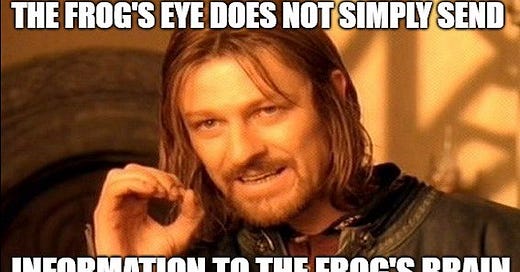What The Frog's Eye Tells The Frog's Brain
One day, Dr. Jerome Lettvin decided to poke JD with a stick.
JD — which stood for ‘Juvenile Delinquent’ — was the name of his son’s pet octopus.
As a world-renowned thought leader in Biology and Artificial Intelligence, Dr. Lettvin (MIT) was studying JD the octopus at the Stazione Zoologica in Naples, Italy. Why? In order to create the world’s first artificial brain, of course.
The next morning I walk into the lab and JD is up on the edge of his 20 foot tank. I walk in and smack! … right in my face…
— Dr. Lettvin (Poet, Psychiatrist, Electrical Engineer, Neurophysiologist)
A fearlessly charismatic Professor, he once famously debated Dr. Timothy Leary on the subject on LSD, agreeing with him on certain subjects (denouncing the prohibition on marijuana 36:53) and outright calling bullshit (40:52) on other subjects.
Dr. Lettvin was so charismatic he once made **Danny Hillis quit Neurobiology**. Danny would go onto invent over 300 patents and perform pioneering work with Disney Imagineering.
Any Product Manager will tell you that Assumptions Kill Companies.
The assumption has always been that the eye mainly senses light, whose local distribution is transmitted to the brain in a kind of copy by a mosaic of impulses… — Dr. Lettvin (In a Frog’s Eye — Conor Myhrvoid (MIT))
In his shocking paper with McCulloch-Pitts & Maturana, Lettvin showed that the Frog’s Eye was organizing information BEFORE sending the information to the frog’s brain.
We were laughed off the stage, literally, at the American Physiology Society in Atlantic City, where we tried to present it [What The Frog’s Eye Tells The Frog’s Brain],” Lettvin told his collaborator Luis Amador in 1986.
Even after the paper was published in 1959, the findings met with considerable skepticism. One disgruntled scientist — fellow MIT researcher Walter Rosenblith — ”felt we were … liars, held a meeting on perception, visual perception, and didn’t invite us,” Lettvin told Amador. Another colleague circumvented the snub by taking conference attendees on an unannounced visit to his lab so they could see for themselves how the experiment was done. The visiting audience was convinced, and Rosenblith soon apologized. “And that,” Lettvin concluded, “was the time that we began to be taken seriously.”
— [Dr. Lettvin, In A Frog’s Eye (MIT)](http://In a Frog’s Eye https://www.technologyreview.com/s/508376/in-a-frogs-eye/
In fact, people still assume that the brain is the only information processor in the body.
Biology is interesting because when you go back and start looking at structure, the structure of cells and things of this sort, there’s an amazing amount of work on it, and awfully good work, but smelling how things fit together is a different story. Now you’re talking about strategy, and strategy is a very different kind of thing: the strategy of operation. — Dr. Lettvin (Poet, Psychiatrist, Electrical Engineer, Neurophysiologist)
Truth: The body’s **eye **AND body’s **brain **work together to process information.
What a Frog’s Eye Tells the Frog’s Brain proved that the Frog’s Eye was organizing information BEFORE it sent the information to the Frog’s Brain.
The discovery that our brain wasn’t the only thing in the body doing the thinking forced scientists to fundamentally rethink their assumptions about the brain and Artificial Intelligence, including Professor Lettvin.
Now look, I’m not saying there are not good physicists who work in astronomy, they’re wonderful, and their apparatus’s are extraordinary! But, oddly enough, a lot of that extraordinary apparatus was already invented by animals. There are animals that are star-guided. It’s surprising how intelligent most animals are.
Standard thinking: The Eyes sends information to the brain.
**Janusian Thinking **(thinking up down, back to front, end to beginning): The Eyes thinks about the information before sending the information to the brain.
Thesis: The brain is the information processor of the body.
**Antithesis: **The eye is the information processor of the body.
**Synthesis: **The eye receives information, processes it, and then sends the processed information to the brain for additional processing.
As we now know, an octopus has neurons in its brain AND its tentacles. Neurons are what the brain uses to think. Lettvin learned just how smart his son’s Octopus JD really was the day after he poked him.
People talk about animals not having a sense of humor, this octopus knew how to play practical jokes, and it was wonderful to watch. My octopus would play practical jokes: “What do you mean an octopus playing practical jokes?!” you say. But it’s true.” — Dr. Lettvin (Poet, Psychiatrist, Electrical Engineer, Neurophysiologist)
While Lettvin didn’t create the world’s first artificial brain in Naples, he learned something he’d never forget after experimenting with JD.
The next morning I walk into the lab and JD is up on the edge of his 20 foot tank. I walk in and smack! … right in my face… he let out a huge squirt of water! He had been waiting for me to come in. Jonathan is in stitches, and then Jonathan says, “Take a look!” and I turn around and there are splotches of water all around the region of where my head would be when I come in. The octopus had planned his revenge and he had been practicing ahead of time. That sounds like a ridiculous story, eh? Well, it isn’t….It’s a very different science that I teach. — Dr. Lettvin (Poet, Psychiatrist, Electrical Engineer, Neurophysiologist)







